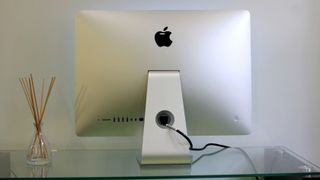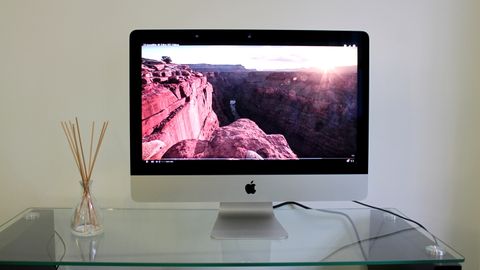Why you can trust TechRadar
The 4K iMac starts at £1,199 (US$1,499/AUS$2,299) - just £300 (US$443/AUS$606) short of the cost of the entry-level 27-inch iMac with 5K Retina Display. Apple's larger iMac gets you a lot more screen and much more powerful components including a dedicated graphics card, so you'll have to consider whether going large represents better value for your wallet.
Alternatively, you could pick up an entry-level 11-inch MacBook Air (£899/US$899/AUS$1,399) and connect it to an affordable 4K monitor such as the Acer CB240HYK (£300) for roughly the same cost. The other option is hooking up the latest Mac mini to a 4K display, which isn't recommended due to that machine's 30Hz limitation when outputting 4K.

Specifications
Here is the spec sheet of the review model provided to techradar:
- Processor: 3.1GHz Intel Quad-Core i5 (Turbo Boost up to 3.6GHz)
- Operating Systems: OS X 10.11 El Capitan
- Memory: 8GB 1867MHz LPDDR3
- Display: Retina 4K 4,096 x 2,304 IPS display
- Graphics: Intel Iris Pro Graphics 6200
- Storage: 1TB Serial ATA Drive @ 5400 rpm
- Dimensions: 45cm x 52.8cm x 17.5cm (H x W x D)
- Weight: 5.68 kg (12.5 pounds)
- Accessories: Magic Mouse 2, Magic Keyboard
When it comes to specs, the iMac with 4K Retina display sits somewhere between the top-end non-Retina 21.5-inch iMac and the entry-level 5K iMac. Compared to the top-sec non-Retina iMac, the 4K model benefits from a higher-clocked sixth-generation Intel Core i5 processor (3.1GHz, versus 2.8GHz), which can be upgraded to a 3.3GHz Quad-Core Intel Core i7 processor with a maximum clock speed of 3.8GHz for a further £160 ($230) - an option unavailable on the standard model.

The 4K iMac comes with a 1TB spinning hard drive as standard. It can be upgraded to a 1TB Fusion Drive that pairs a 1TB hard drive with 24GB of flash storage (used for installing OS X, which allows for faster boot times), and further upgrade options include a 2TB Fusion Drive, a 256GB Flash Storage drive or a 512GB Flash Storage drive.
The 4K iMac's ports remains unchanged from the non-Retina 21.5-inch iMac. You get four USB 3.0 ports, two Thunderbolt 2 ports, an SDXC card slot, Gigabit Ethernet and Kensington lock slots. Wireless is taken care of via 802.11ac Wi-FI that can reach speeds of up to 13Gbps, and there's also Bluetooth 4.0 for hooking up peripherals.
Apple revamped its accessories with the re-launch of the 5K iMac. The same new (and much improved) Magic Keyboard features, along with a redesigned Magic Tracpkad 2 and Magic Mouse 2. All of the revamped peripherals feature a rechargable lithium ion battery inside, rather than the standard AA type.
Performance
When it comes to performance, the 4K iMac's major flaw is apparent as soon as you've turned it on. The default 1TB 5400rpm drive is tortoise-like in speed and doesn't boot as quickly as you might be used to coming from an SSD-equipped laptop.
The hard disk's slow speed is less noticeable once you're on the desktop. Apps load relatively quickly, and the 8GB of RAM keeps everything ticking along smoothly. However, I'd go as far to say that the 4K iMac is only worth bothering with if you're looking at upgrading to at least the 1TB fusion drive for another £80 ($117/AUS$161), if only to save yourself sitting through longer boot and sleep resume times. If you've got the money to spare, upgrading again to the SSD option would ensure fastest performance all round.
- Read more: our guide to the best Mac VPN

Benchmarks
- Xbench: Overall: 653.25; CPU: 405.54
- Cinebench R15 Single Core: 150cb; Multi Core: 580cb; Open GL: 45fps
- Unigine Heaven 4.0 Medium Quality (2,560 x 1,440): Score: 257
- Unigine Heaven 4.0: Ultra quality (2,560 x 1,440): Score: 184
- Novabench: Score 831; Graphics: 69
The 4K iMac isn't equipped to handle games like the 5K Retina iMac is, but the smaller iMac's Intel Iris Pro Graphics 6200 is enough for light photo and video editing in addition to running the occasional lesser demanding game. To compare the two, the 5K iMac, which houses a dedicated AMD Radeon R9 M390, scored 102% more in Novabench's graphics test than the iMac 4K, its 2GB of dedicated GDDR5 video memory making a world of real difference. If you're looking at playing modern titles like The Witcher 3, you're better off opting for Apple's larger machine - or a Windows PC.
Apple chose not to mess with the non-Retina 21.5-inch iMac's decent speakers, which once again provide clear sound on the 4K iMac. They're pleasingly loud without being overbearing at full volume, capable of pumping out decent mid-range tones and just enough bass to do rock and dance music justice.
Current page: Specifications and performance
Prev Page Introduction, design and display Next Page Verdict

